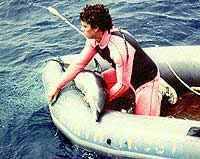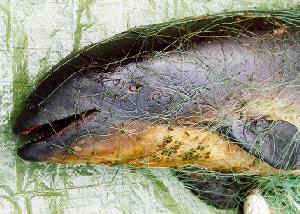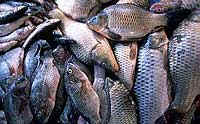As Jesus was walking beside the Sea of Galilee, he saw two brothers, Simon called Peter and his brother Andrew. They were casting a net into the sea, for they were fishermen. "Lay down your nets and follow me," Jesus said, "and I will make you fishers of men." At once they left their nets and followed him. Matt 4: 18-20
For millennia, fish have been taken from the world's oceans, lakes, and rivers and killed by humans for food. In recent decades, consumer demand for seafood has increased in the U.S., while new technologies have improved our ability to find and catch fish. Over the latter half of the 20th century, wild catches have increased by approximately 500% to nearly 100 million tons per year.
That human beings regard fish as objects of sport or consumption is one of society's many inconsistent attitudes toward animals. Millions of fish annually are subjected to severe suffering and agony by "sport" or "recreational" fishing and by the commercial fishing industry.
The Painful Reality
| The poet Byron said it best: "[T]he art of angling [is] the cruelest and the coldest of pretended sports." "Sport" fishing generally refers to fishing with a rod and reel, but may include the use of bows and arrows, small nets, spears, or guns. It survives partly because of the misconception that fish don't feel pain. Fish express pain and suffering in ways that humans can easily recognize as they gasp and struggle when caught. |  |
Scientific reports from around the world substantiate the fact that fish feel pain. For example, a U.K. inquiry into angling and shooting, known as The Medway Report, concluded: "[T]he evidence suggests that all vertebrates including fish... experience similar sensations to a greater or lesser degree in response to noxious stimuli." Fish feel pain out of biological necessity, just as mammals do. Without the ability to feel pain, they would not be able to survive.
Hooked fish struggle out of fear and physical pain. Once fish are brought out of their environment and into ours, they begin to suffocate. Often their gills collapse and the swim bladder can rupture due to the sudden change in pressure on their bodies. Anglers also often impale their victims on a "stringer" and dangle them in water so that they won't die quickly and "spoil."
Fish who are released can suffer such severe stress from being "played" that they may die even though they manage to swim away or may be so weakened that they are easy prey for predators. The "fight" to survive during catch and release can cause a buildup of lactic acid, making the fish stiff and sore, lessening their chances of survival.
Many trout streams are so intensively fished that they are subject to "catch and release" regulations requiring that all fish caught must be let go; the aquatic animals in these streams are likely to spend their entire short lives being repeatedly traumatized and injured.
Terry Hill, a former angler, recalls: "On several occasions, I caught fish who had hooks actually embedded in their lips. What had happened was, earlier in that fish's life, a hook had been lost by a fisherman and had embedded itself in the fish's lip. As the fish had grown, the lip had actually grown over the hook. [In some cases,] the hook had actually been swallowed by the fish and become embedded in the fish's stomach. The fish was actually pulled out by the gut. The fisherman would normally become frustrated and would pull the hook out, actually pulling the fish's guts out through the mouth."
Health Food?
| Eating the flesh of fish causes health problems for many people. Like the flesh of other animals, it contains excessive amounts of protein, fat, and cholesterol, and can cause food allergies. Naturally occurring toxins (e.g., "red tides") can even be fatal to humans. |  |
Fish (including shellfish) can accumulate extremely high levels of chemical residues, as much as 9 million times that of the water in which they live. Fish flesh may store contaminants such as PCB's, strongly suspected of causing cancer, nervous system disorders, and fetal damage; dioxins, also linked to cancer; radioactive substances like strontium 90; and toxic metals like cadmium, mercury, lead, chromium, and arsenic, which can cause health problems ranging from kidney damage and impaired mental development to cancer.
Commercial Carnage
Today's commercial fishers use vast "factory" trawlers the size of football fields and advanced electronic equipment and satellite communications to track fish. (Large operations also use airplanes or helicopters.) Huge nets, sometimes miles long, stretch across the ocean, swallowing up everything in their path.
 |
Factory trawlers are emptying the oceans of sea life at
an alarming pace. Thirteen of the 17 major global fisheries are
depleted or in serious decline. The other four are
"overexploited" or "fully exploited."
Nearly one-third of all species of fish have declined in population in the last 15 years and many species may be wiped out in the next decade. |

